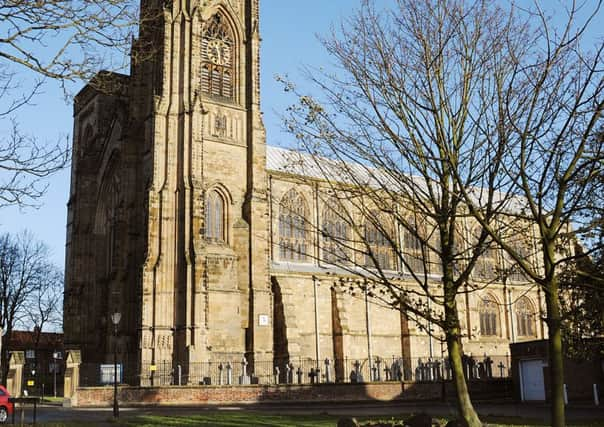Nostalgia: The age of plunder


Yorkshire’s nunneries were numerous, small and relatively poor. Of the 24, six at Arden, Arthington, Baysdale, Ellerton, Handale and Nunburnholme had annual incomes of less than £20; Rosedale had nine nuns and an income of £37; at Wykeham, 13 nuns lived on £26 a year; and at Yedingham, ten shared £22. With receipts of £82 a year, Swine’s 15 nuns were the richest in the county.
However, the monks were much more affluent. St Mary’s at York had a total annual value of £2,500; Fountains, £1,200; Selby, £739; Bridlington, £682; Guisborough, £628; Jervaulx, £455; and Whitby, £437. Most of these revenues came from rents, tithes, farming stock and crops. Each of the monasteries in the North Riding owned many thousands of sheep.
Advertisement
Hide AdAdvertisement
Hide AdBy the spring of 1540 all of Yorkshire’s religious houses, great and small, had been confiscated by the Crown. However, if the royal treasury had kept all these properties it would have strengthened the monarchy enormously, but wars with Scotland and France in the 1540s were so expensive that Henry VIII’s ministers were selling monastic land and spending abbey assets almost immediately. By Henry’s death in 1547, two-thirds of all former religious properties had been sold off.
The sale of Yorkshire’s ex-monastic land continued under the reigns of Henry’s children, so that by 1603 virtually none of it remained royal. In fact, most of it had passed by gift, sale or lease to the county’s gentry.
Many of these beneficiaries actually made their new homes in the buildings and on the demesnes of former religious houses. Sir Thomas Chaloner bought Guisborough Priory in 1550 and his son made it into the family seat; Sir Stephen Proctor built himself a fine Jacobean mansion out of the ruins of Fountains; the Bellasis family took up residence in Newburgh Priory; the Gargraves adopted Nostell; and the Cholmleys abandoned their castle at Roxby in Ryedale and built themselves a new home on the site and out of the claustral remains of Whitby Abbey. Other already established gentry and aristocracy in the county enlarged their estates with purchases of ex-monastic property: the Constables of Everingham bought Drax Priory; Sir Leonard Beckwith, the Crown’s receiver for Yorkshire, mopped up several manors and rectories that had belonged to Selby Abbey. The Hothams of Scorborough in the East Riding concentrated their holdings between Great Driffield and Beverley, but also bought distant lands such as the abbot of Whitby’s hunting lodge and deer park at Fyling.
Coming closer to home, the Hutchinsons settled at Wykeham Abbey and soon acquired a coat of arms. They did not have to survive on the £26 a year that had supported their predecessors there, the 13 Cistercian nuns. Sir Thomas Hoby also was fortunate: he found himself a wife and an estate at Hackness which had once been part of the Whitby Abbey estate. And another “foreign” Protestant planted in Yorkshire, Sir Henry Gate, owed his rapid advancement to royal favour and acquired the manor of Seamer from the Crown, and the valuable rectory of St Martin’s and its subordinate chapels at Cayton and East Ayton which had also belonged to the Benedictines of Whitby.
Advertisement
Hide AdAdvertisement
Hide AdOf special interest is the fate of the properties of three local monasteries: those of the Augustinian black canons of Bridlington Priory, the Benedictine black monks of Whitby Abbey and the Cistercian white monks of Rievaulx Abbey. All had close associations with Scarborough and its hinterland.
Both the seaports of Whitby and Bridlington had been dominated by their abbeys so that a vacuum was created by their sudden and complete closure; but there the similarity ends.
Bridlington Quay, which consisted of two piers, north and south of the exit into the sea of the Gypsey Race, was little more than an anchorage with a few houses; whereas Bridlington town, a mile inland, consisted of one long major street running eastwards to the Priory gatehouse and north and south back lanes with names such as Westgate, St John’s gate, Kirkgate and Bayle Street. At a military muster, Bridlington had 118 armed men and the Quay only 22.
At the time of the dissolution when the last prior, William Wood, was “beheaded and quartered” at York for aiding the Pilgrimage of Grace, visitors to Bridlington were astonished to find so much extreme poverty in the midst of so much evidence of great wealth: “I never saw so nedy people in my lyve as are in these parties”, wrote one. Parish church and harbour were in ruinous decay, whereas the monastery itself, church, dormitory, cloisters, refectory, farm buildings and huge fish pond, were on the grandest scale. For example, the malt house in the precinct alone measured 44 by 17 yards and was used at harvest time as a dining room for the Priory’s servants.
Advertisement
Hide AdAdvertisement
Hide AdOn the whole, the disappearance of Bridlington Priory was a benefit to the locality. The eastern third of its church was demolished and its stone re-used to repair the Quay’s piers. Residents in the town took full advantage of the availability of building materials to improve their timber and thatch cottages. Only the gatehouse to the Priory survived intact. The remainder of the priory church, that had once been 333 feet long, became the town’s parish church and the lay tenant of the malt house made enough beer to export the surplus to Newcastle and London. Bridlington beer soon became as famous as Scarborough cod and Whitby butter. As for the manor of Bridlington, worth nearly £250 a year in 1539, this was eventually leased by Queen Elizabeth to a succession of local men who failed to pay the rent until, along with Scarborough castle, it was given to John Ramsey, earl of Holderness, by King James I. Finally, in 1630, Sir George Ramsey sold the manor to 13 feoffees or trustees.
[to be continued]